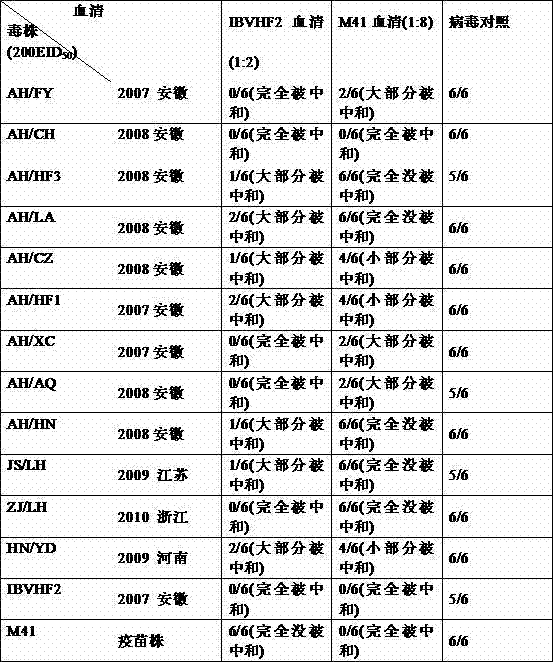Avian infectious bronchitis virus vaccine strain (HF2 strain) and application thereof
A technology for bronchitis and virus vaccines, applied in antiviral agents, viruses/bacteriophages, medical preparations containing active ingredients, etc., can solve problems such as the propagation of vaccine strains not adapting to new epidemic strains, and achieve the solution The effect of disease
- Summary
- Abstract
- Description
- Claims
- Application Information
AI Technical Summary
Problems solved by technology
Method used
Image
Examples
Embodiment 1
[0020] 1. Virus isolation and culture
[0021] Aseptically collect the kidneys of dead chickens, add sterilized saline at a ratio of 1:5, grind, freeze and thaw 3 times, centrifuge at 5000rpm for 20min, filter and sterilize the supernatant, and inoculate 10 days-old SPF chicken embryos in the allantoic cavity eggs, 0.2ml per embryo, incubate chicken embryos at 37°C, irradiate embryos twice a day, discard dead embryos within 24 hours, take 5 embryos within 96 hours to harvest allantoic fluid, and continue to incubate until 144 hours, record chicken embryo lesions Condition. So blindly passed on for 5 generations. Harvested virus was stored at -80°C. The chicken embryos of the 3rd generation showed typical pathological changes caused by the virus, which manifested as growth retardation of chicken embryos, curling up of embryo bodies, and dehydration. To the fifth generation, the virus content was determined to be 10 5.5 EID 50 / 0.1ml.
[0022] 2. Virus identification
[0...
Embodiment 2
[0044] 1. Continuous subculture of chicken embryos weakened the virus strain
[0045] Use 9-11-day-old SPF chicken embryos for continuous passage to weaken the IBVHF2 strain, inoculate 5 chicken embryos through the allantoic cavity in each passage, 0.1ml / piece, incubate at 37°C, discard dead chicken embryos within 24 hours, 40 Two live embryos were harvested in about 1 hour, and the embryo fluid was collected aseptically for the next subculture, and the rest were kept for 144 hours to observe whether there were branched lesions in the chicken embryos. This was continuously passed down to the 100th generation. During a certain interval, virus content, sterility and mycoplasma detection, exogenous virus detection, and safety tests on susceptible chicks were carried out to determine whether the virulence was attenuated.
[0046] 2. Determination of virus content
[0047] The EID50 of the E5, E10, E30, E50, E70, E80, E90, and E100 viruses were measured during the subculture proc...
Embodiment 3
[0064] 1. Preparation of IBV virus liquid Dilute the above-mentioned HF2E80 as a seed poison 1000 times with sterilized normal saline, inoculate 100 10-day-old SPF chicken embryos in the allantoic cavity, 0.1ml per embryo, seal the pinhole, and continue to incubate at 37°C. There is no need to turn the eggs, and the eggs are illuminated once within 30 hours after inoculation, and the dead embryos are discarded. After that, the eggs are illuminated once every 4 to 6 hours, and the dead chicken embryos are taken out at any time until 40 hours. The chicken embryos are taken out, the air chamber is upright, and placed at 2-8°C to cool for 24 hours. Take out the cooled chicken embryo, sterilize the air cell, and then use aseptic surgery to peel off the egg shell of the air cell, remove the egg shell membrane, cut the chorioallantoic membrane and amniotic membrane (do not break the yolk), and absorb the chicken embryo fluid , samples were taken for inspection, and stored below -25°C...
PUM
 Login to View More
Login to View More Abstract
Description
Claims
Application Information
 Login to View More
Login to View More - R&D
- Intellectual Property
- Life Sciences
- Materials
- Tech Scout
- Unparalleled Data Quality
- Higher Quality Content
- 60% Fewer Hallucinations
Browse by: Latest US Patents, China's latest patents, Technical Efficacy Thesaurus, Application Domain, Technology Topic, Popular Technical Reports.
© 2025 PatSnap. All rights reserved.Legal|Privacy policy|Modern Slavery Act Transparency Statement|Sitemap|About US| Contact US: help@patsnap.com


